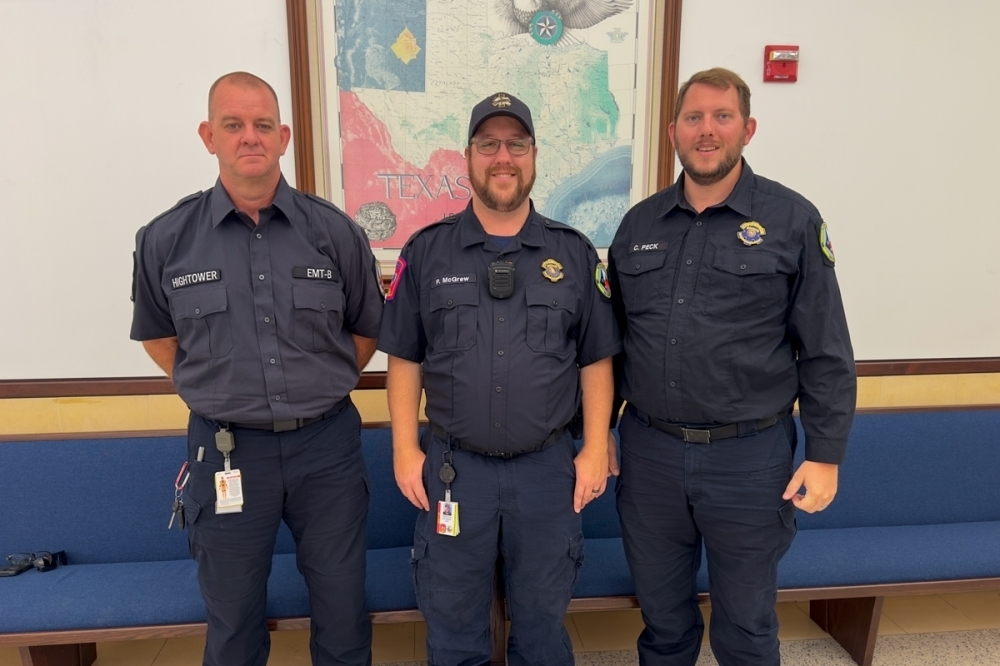Two-minute impact
At a June Bastrop County Commissioners meeting, Bastrop County First Responders volunteer Preston McGrew, one of three medics spearheading the campaign, said Emergency Services District No. 3 would provide local ambulance services for the nearly 900-square-mile county. This change would nearly triple the number of units in the area, which is currently serviced by four units through Acadian, whose contract expires in May 2025.
Throughout the summer, McGrew, along with fellow BCFR volunteers Caleb Peck and Paul Hightower, made their case at City Council meetings.

If approved by voters, ESD No. 3 would be funded through property taxes at $0.10 per $100 of a property’s valuation—the same amount used for other ESDs in the county. This would equate to an increase of $200 per year in property taxes on a home with an assessed value of $200,000.
“I don’t want to pay more taxes than I have to either, but I would pay double the amount that we are talking about today to ensure that we have better ambulance services in this county,” McGrew said.
What they're saying
Bastrop County Commissioners, as well as each City Council within the county, unanimously approved placing the proposition on the November ballot—except for the city of Elgin and its extraterritorial jurisdiction. Elgin officials decided to opt out at a meeting on Aug. 6.
"I'm not sure ... everyone understands all the potential ramifications and impacts of this proposal," Elgin City Manager Thomas Mattis said during the meeting, adding that his main concerns were with there being no binding commitments from ESD No. 3 to:
- Have an Elgin representative on the ESD No. 3 board
- Have EMS facilities housed in Elgin
- Have EMS units stationed in Elgin
Mattis said in his experience, when tax dollars are collected from citizens, the final decision on expenditures is "always done by a governing body elected by the people."
"That will not be the case with ESD No. 3," Mattis said. "Frankly, I didn't think that was even possible."
McGrew disagreed, citing Texas Health and Safety Code 775.305, which states the board must submit the following to the commissioners for approval, including:
- An annual budget
- Tax calculations, notices and recommendations
What else?
Mattis said regardless of the outcome of the November election, Elgin officials recognize there is a need to expand EMS units for the city.
On Aug. 27, council members signed a letter of intent with Acadian to continue services with them if needed.
"The LOI with Acadian is our safety net," Mathis said. "It is our backup plan. If the Elgin voters support a new tax rate or fee increase equivalent, then I think the city at least needs to think about whether we would be better served by having that money stay here in town and having the City Council make a decision about how those funds are expended to support the citizens of Elgin."
Matis said in the meantime, city officials will continue to explore options.
How we got here
McGrew and the trio began planning ESD No. 3 after seeing a pattern of long response times across the county—often between 45 minutes to an hour, regardless of the emergency.
“We frequently see it go to level zero, which means there are no ambulances available anywhere in the county,” McGrew said. “When that happens, an ambulance is sent in from another location—whether that is San Marcos, Austin or sometimes even as far as Jarrell.”
Volunteers like McGrew, Peck and Hightower have been responding to help stabilize patients as best they can, but their hands are sometimes tied because they are not legally allowed to transport anyone, McGrew said.
“This just isn’t sustainable as a long-term solution, especially with the population growth we are seeing in Bastrop County,” McGrew added.
The approach
With the addition of ESD No. 3, McGrew said some of their goals include:
- Building nine stations strategically placed throughout the county to facilitate a maximum 15-minute response time for any call
- Staffing 10 ambulances, with room to accommodate more as the county grows
- Creating 85 “good-paying jobs” to run ESD No. 3
- Working with county officials to employ 911 dispatchers who are trained and able to assist with triage and cardiopulmonary resuscitation over the phone
McGrew said the team would immediately get to work if the proposition is approved by voters in November, adding that the process would take between 12-18 months.





